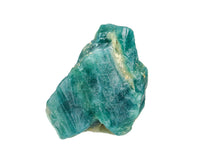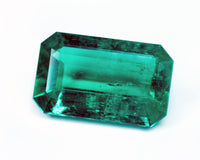- 1. Rainbow Moonstone
- 1-1. Rainbow Moonstone Colors
- 1-2. Moonstone Cut
- 1-3. Rainbow Moonstone Deposits
- 2. Rainbow Moonstone History
- 3. The Meaning of the Rainbow Moonstone
- 4. Healing Properties
- 5. How to Tell Real Moonstone from a Fake?
Rainbow Moonstone
Rainbow moonstone is an exceptionally beautiful and fairly rare mineral. Despite a rather cold appearance, this precious gem boasts undisputable fascination.
Rainbow moonstone, which is a variety of white labradorite, albite, and oligoclase, is known for its delicate creamy color with shimmering streaks that resemble the moonlight. The mesmerizing glow of the gemstone, otherwise known as adularescence, is the result of translucent prismatic and lamellar crystals producing bluish-white flashes. This amazing phenomenon became possible due to the layered internal structure of the gem. Moonstone is a mixture of two types of feldspar - orthoclase and albite, which are arranged in alternating layers. When light hits the mineral, it is refracted from certain layers and scattered from others. This is how a one-of-a-kind light phenomenon is born. Thanks to adularescence, the moonstone is so unique and sought-after.
Rainbow Moonstone Colors
Moonstones traditionally feature translucent milky white or light gray hues mixed with blue or lilac flashes. When you twirl these gems in your hands, it seems that an internal multi-dimensional shimmer illuminates them from the inside. Besides translucent bluish gems, there are also specimens with star-shaped patterns and Cat Eye effects, although they are hard to come by. The rarest type of rainbow moonstone features light yellow color.
Moonstone Cuts
Cabochon is the most common cut for rainbow moonstones. Thanks to this cut, the gem reveals its beauty and iridescence to the max. The bottom of the cabochon can be flat or slightly convex. The classic cabochons shapes are oval and round, with cushion, pear, and marquise being popular as well.
Faceted cuts are rather rare for moonstones due to the lack of hardness and tendency to acquire scratches. It is also believed that iridescence is manifested much more subtly with rectangular or hexagon cuts. Nevertheless, with a thoughtful and skillful approach to cutting, faceted rainbow moonstone will retain and even multiply its majestic radiance.
Rainbow Moonstone Deposits

Rainbow Moonstone Rough
Moonstone is the commercial name for minerals of similar physical and geological properties, predominantly white labradorite, albite, and oligoclase, and their deposits are found around the globe. As for the rainbow variety, it is only available in a few places: Sri Lanka, Tanzania, India, Madagascar, Burma, and Ceylon. Raw materials from India are considered one of the best due to their inexpensive price and amazing multi-colored flows.
Rainbow Moonstone History
The history of rainbow moonstone begins thousands of years ago when our ancestors discovered minerals that boast a splendid play of colors. Many sources refer to the Ancient Greeks and Romans who used the gemstone in jewelry. However, you should take this information with a grain of sail. The truth is that rainbow moonstone deposits are not found in Europe, so it is unlikely that the stone was known in antiquity. Instead, the iridescent gem has many deposits in Asia, so its history is much richer there.

Art Nouveau building
The Western world was able to appreciate the beauty of the moonstone in the early 20th century during the reign of Art Nouveau in fashion. The magical multicolored flashes caught the eyes of jewelers and then they won the hearts of fashionistas around the world.
The Meaning of the Rainbow Moonstone
Many nations considered rainbow moonstone the gem of lovers. They used it to carry our rituals to attract love. People who sought affection would wear moonstone brooches on the left side, close to the heart. They believed that the iridescent stone helped find a partner and awaken the feelings. It was said that the gemstone is capable of saving a person who wears it from loneliness.
In many countries, rainbow moonstone is considered sacred because of its mystical effects. People noticed that it reacts to various phases of the moon. On a new moon, the stone as if oozes moonlight - its surface gets colder and the color becomes more vibrant. As the moon is waning, the stone's radiance diminishes drastically. Thus, you can observe the connection between the moonstone and the Earth's satellite. The nature of such an amazing phenomenon has never been studied.
Rainbow moonstone: Healing Properties
Moonstone has a powerful healing effect on the human body. For centuries, the mineral has been used to prevent epileptic seizures as well as treat kidneys and liver diseases. On top of that, the gemstone spreads its beneficial effects on the cardiovascular and genitourinary systems, digestive tract, and pituitary gland. It improves heart function, purifies the blood, and facilitates childbirth. In Medieval times, it was believed that moonstones 'wept' on moonlit nights, and the fluid it produced helped cure fevers. Our ancestors presumed that moonstones realized their full potential only when they touched the skin. Therefore, gemstone beads arranged in a necklace or bracelet offer a more powerful effect than, let's say, rings.

The Earth's satellite has both positive and negative effects on a person's well-being. While moonstone enhances the positive effects of the heavenly body, it also protects against its harmful impacts. Jewelry featuring this stone is effective to alleviate epileptic seizures, reduce insomnia, get rid of fears, and gain more control over your emotions.
Rainbow moonstone corresponds to the water element. Therefore, it has a beneficial effect on body processes that one way or another concern fluids. It is believed to help remove kidney stones, heal tumors, detoxify the body, as well as reduce swelling and inflammation. Moonstone is a perfect companion for people born under the water signs of the Zodiac - Pisces, Cancers, and Scorpios, plus Gemini and Libra to a lesser degree. The signs that represent the fire element (Aries, Leo, and Sagittarius) should be cautious about wearing rainbow moonstone jewelry since it may cause mental anguish and self-doubt.
Since ancient times, people have been turning to moonstone for mental support. This natural shrink is able to help battle melancholy, depression, fear, stress, and emotional turmoil. Besides that, people believe in its power to reduce tantrums and cope with uncontrolled desires.
How to Tell Real Rainbow Moonstone from a Fake?
Rainbow moonstone is very popular in jewelry-making. You can find it in pendants, bead necklaces, rings, and earrings. Moonstone for sale is also available in loose stones if you'd like to craft jewelry on your own. That being said, you should be very careful when buying rainbow gemstones because unscrupulous sellers may sell so-called opal glass in the guise of moonstones. Opal glass features a silky blue color, it is translucent and cheap but, unfortunately, has nothing to do with genuine rainbow moonstones.
Luckily, is not that hard to tell the real thing from imitations. The simplest test is to look at the stone in question under the direct and incident light. Opal glass is going to turn yellow or orange under direct illumination and creamy blue under the incident light. On top of that, inexpensive faux moonstones often contain tiny bubbles and streaks. A real moonstone looks different. Its color won't change when it is illuminated but adularescence appears only in the incident light.

With Kenkengems, you don't have to worry about genuineness. Every rainbow moonstone for sale that we offer is 100% natural. Make sure to check out our inventory of gemstone beads and loose stones in cuts that vary from cabochons to hexagons.



